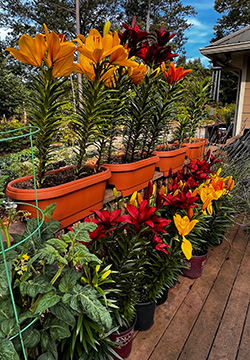
Asiatic Lilies
Want some brilliant color in your garden or containers? Check out Asiatic lilies.
Although this year’s lily planting season has passed, you can mark your calendar to make an amazing impression in your landscape next spring. Asiatic lilies are easy to grow, put on an amazing and colorful show and come back year after year.
Last fall I ordered packages from Longfield Gardens online. The company is my go-to for all kinds of bulbs, including bulk purchases of daffodils, grape hyacinth, scilla and other early spring bloomers. Each fall I purchase at least a half-dozen amaryllis bulbs – Longfield’s are the largest and most reliable bloomers – to force indoors in water at the holidays.
Asiatic lilies, while similar in appearance to Oriental lilies like the popular florist Stargazer, are a better investment in my book. They come in a wide range of colors, from red and orange to yellow, pink and bi-colored.
Growing to a height of 18 to 24 inches, they’re great for cut flowers indoors. Asiatic lilies lack the strong fragrance of Oriental lilies, which can be bothersome to some people. And like Orientals, you’ll need to pick off the pollen-laden stamens that can stain your hands and fabrics if you’re cutting them to bring inside.
Asiatic lilies tend to be more deer-resistant than Oriental lilies.
They’ll come back year after year if you feed them with bloodmeal or another bulb fertilizer after they’ve bloomed, then keep the leaves on the plant until they turn brown.
There’s no need to dig the bulbs in the winter; just lightly mulch them in the fall.
Hungry veggies
If you’re growing food crops, such as tomatoes, beans, peppers, okra and eggplant, remember to feed them about every three or so weeks during the growing season. If you’re using containers or grow-bags, they will need to be fed more often, because the nutrients will be washed through the soil when you water.
Containers, especially grow bags, need more water than raised beds. Just be careful to water at the roots and avoid getting the leaves wet, which can encourage diseases caused by fungi, bacteria and viruses.
This year I got carried away and now have 50 very healthy tomato plants in our raised beds and in grow-bags along the driveway. Heirlooms, like Cherokee purple and black krim, and a few new hybrids from the National Gardening Bureau, including zebra and California gold, Rick says we need to set up a tomato stand if they all get ripe at once!
Bunnies, rabbits and deer
Rabbits are flourishing this season. From making appearances along the side of the road to popping up in yards and gardens, these cute little furry creatures can be charming. And, with the further development of our roadside forests into homes for people, the bunnies are losing their habitat.
It’s not unusual to see rabbits in the garden, because like Peter Cottontail says, the food is always greener at Mr. McGregor’s – or yours.
You can reduce the damage they make fairly easily, but consistency is the key. My favorite wildlife repellants are Liquid Fence and Hinder. I buy the concentrate in gallon jugs.
Both stink to high heavens, and that’s just what you want. Mix according to package instructions and use a 1- or 2-gallon sprayer. Liberally wet foliage of your garden veggies, hydrangeas, daylilies and flower crops.
The putrid, pungent smell will dissipate in about 6 hours and the rabbits and deer will find somewhere more tasteful to forage. I sprayed every week to 10 days early in the spring for three or four applications, and now the wildlife knows that plants in my yard don’t taste good.
Spray first thing in the morning. Then you’ll have to take a shower to wash off the smell, but it’s so worth it to keep bunnies and deer at bay.
Photo: by Pamela A. Keene





